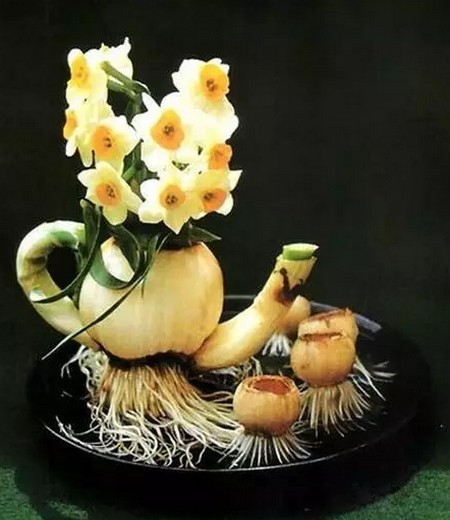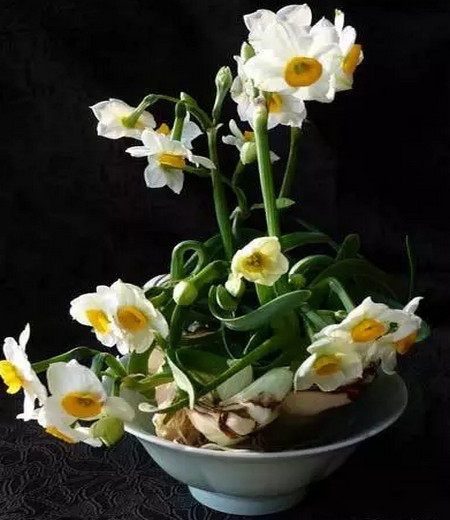Modeling method and Management of Narcissus Bonsai carving
Daffodils are elegant in color and quiet in aroma. Families often do hydroponics and blossom around the Spring Festival. They are known as "Lingbo fairies". Careful friends will find that some of the bulbs in the flower market have been cut, not because the balls have been removed by the store, but because it is a means to promote the flowering of daffodils and to make daffodils-daffodils carving.

Narcissus carving refers to the modeling of Narcissus through carving, which is an auxiliary technology for Narcissus viewing. Carving to destroy the development of cells and tissues, resulting in abnormal growth to complete the modeling. Plants have the characteristics of growing to light (aboveground part) and to injury, so they can make the leaves grow in the direction they want by adjusting the light source and scratching parts.
1. Carving time
The bulb bulb grows out of the main bud about 3 cm, and there is no new root at the bottom. If the new root has grown, sturdy, straight and white, the length is about 1 cm.
If the bulb is carved as soon as the main bud is exposed, because the leaf is too short, the leaf edge is cut off and the leaf is sickle-shaped (straight up and down), and the shape is not coordinated. If the blade is too long (more than 5 cm), it is difficult to achieve the ideal shape after carving.
2. remove withered roots and withered bulb bark
Remove the withered roots and soil at the bottom of the bulb, as well as a layer of brown bark outside the bulb.
3. Peel the bulb
Cut a knife about 1 cm above the root. Beginners should not cut too deep at one time, so as not to cut off the leaves and flower ridges.
4. Carve leaf bracts
The scales on both sides of the leaf bud are slowly removed so that the whole leaf bud is exposed. Be patient and meticulous and don't hurt the leaf buds.
5. Cutting edge
Lift the flower bud column to be cut with the middle or index finger or ring finger of the left hand, facilitate the spread of the leaf layer, cut off 1/3 of the leaf edge with a knife, and bend to which side of the cut.
6. Carved flower stalk
The upper part of the flower bud is the bud and the lower part is the pedicel. When carving a pedicel, cut off the pedicel from top to bottom to a depth of about 1 pedicel.
7. The treatment of the ball.
The ball next to it can be kept or not according to the shape, and the carving method is the same as that of the mother ball.
8. Maintenance after carving
Immersion: the carved bulb should be immersed in water immediately and the water temperature should be the same as room temperature. The carved wound is face down, take it out after soaking for 1 day, hold it, shake off the exudated glue-like mucus, change the fresh water and soak again for 1 day, and then shake off the mucus according to the above method. In this way, the wounds of scales, leaves and other places can be healed to maintain the original color.
Cover cotton root protection: after flooding daffodils, generally after 10 days or so flat maintenance (ship, teapot and other modeling, after carving should make the wound face up). Do not use too much water. If you exceed the bulb wound, it is easy to cause mildew and rot. If you leave the water for a long time, it will dry up. Therefore, a thin piece of skimmed cotton is covered on the root plate at one end and immersed in water at one end. The moist cotton piece plays the role of root protection, which can ensure the normal growth of daffodils.
Adjustment and placement: after about 10 days of maintenance, the root of the carved daffodil ball has grown to 3mi 5cm, and the leaves are basically curled in the expected direction. At this time, it should be adjusted and managed separately. Some are still raised in flat water, such as crabs; some have to leave the water, tilt upward, and finally put the daffodil ball up, such as an elephant; others need to stand obliquely, so that the uncarved side of the bulb becomes an ornamental surface, such as gourds.
Trimming: not all bulbs raised by carved water can grow according to the intention of modeling, so they need to be trimmed at this time. The trimming objects are roughly divided into two categories: one is the improper direction and position of flowers and leaves, which need to be induced and processed; the other is that the initial carving time is not cut in place, and after a period of maintenance, the problem is highlighted. No matter what kind of problem you solve, you should be very careful as long as you use the knife. After carving water-raised bulbs, leaves and pedicels are so fragile that they will be broken if you don't pay attention to them. Some carving shapes, once the lack of flowers and leaves, can not be made up for.
Time: 2019-06-11 Click:
- Prev

Modeling method of Narcissus Bonsai
The carving shape of daffodils can be carved according to different shapes of bulbs, coupled with the author's intention, careful conception, ingenious effort, carved layout, meticulous water culture and gradual trimming, it can become a beautiful work of art full of variety and vitality. Beginners start with simple carving. The method is very simple.
- Next

Sowing and propagation techniques of Dutch chrysanthemum
Dutch chrysanthemum is suitable for potted indoor viewing and layout of flower beds, flower borders and so on. It is more suitable for flower basket and flower arrangement. Such as a variety of cooperation main materials, with Dutch chrysanthemum, longevity flowers, spring feather, Penglai, the picture is very lively, placed on the coffee table, publication table. It looks particularly fresh and pleasing to the eye. If you take colorful Dutch chrysanthemum as the main flower vase
Related
- Fuxing push coffee new agricultural production and marketing class: lack of small-scale processing plants
- Jujube rice field leisure farm deep ploughing Yilan for five years to create a space for organic food and play
- Nongyu Farm-A trial of organic papaya for brave women with advanced technology
- Four points for attention in the prevention and control of diseases and insect pests of edible fungi
- How to add nutrient solution to Edible Fungi
- Is there any good way to control edible fungus mites?
- Open Inoculation Technology of Edible Fungi
- Is there any clever way to use fertilizer for edible fungus in winter?
- What agents are used to kill the pathogens of edible fungi in the mushroom shed?
- Rapid drying of Edible Fungi

